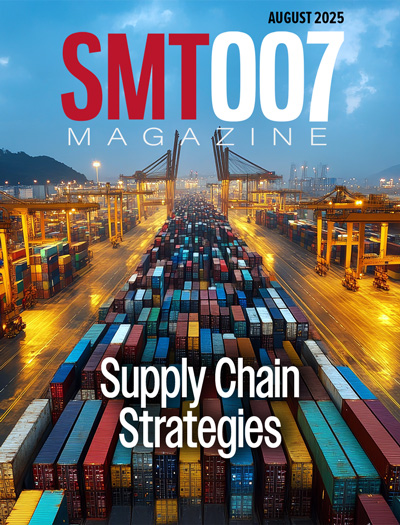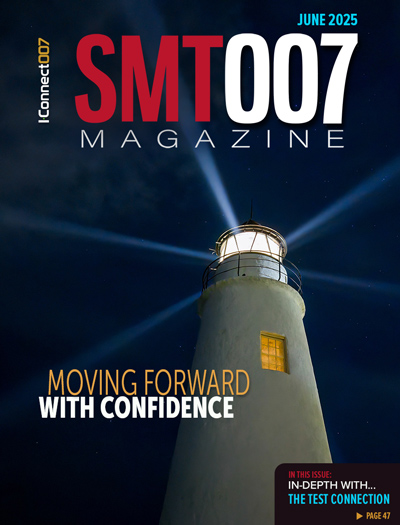-

- News
- Books
Featured Books
- smt007 Magazine
Latest Issues
Current Issue
Supply Chain Strategies
A successful brand is built on strong customer relationships—anchored by a well-orchestrated supply chain at its core. This month, we look at how managing your supply chain directly influences customer perception.

What's Your Sweet Spot?
Are you in a niche that’s growing or shrinking? Is it time to reassess and refocus? We spotlight companies thriving by redefining or reinforcing their niche. What are their insights?

Moving Forward With Confidence
In this issue, we focus on sales and quoting, workforce training, new IPC leadership in the U.S. and Canada, the effects of tariffs, CFX standards, and much more—all designed to provide perspective as you move through the cloud bank of today's shifting economic market.
- Articles
- Columns
- Links
- Media kit
||| MENU - smt007 Magazine
Argonne Develops Plans to be Sure Nuclear Power Plants Stay Cool
April 5, 2024 | BUSINESS WIREEstimated reading time: 2 minutes
Climate scientists and nuclear science and engineering experts at the U.S. Department of Energy’s (DOE) Argonne National Laboratory are joining forces to develop a plan B for nuclear power in Richland, Washington.
Scientists at the Lab will use Gateway for Accelerated Innovation in Nuclear (GAIN) funding from DOE to work with Washington’s Energy Northwest to inform the design and selection of future nuclear reactor cooling systems and their impacts on electricity cost.
Rick Vilim, manager of the Plant Analysis and Control and Sensors department in Argonne’s Nuclear Science and Engineering division, leads the effort with Rao Kotamarthi, senior scientist in Argonne’s Environmental Science division.
According to Vilim, the most economical and best way to cool a reactor is to use a local, flowing waterway, such as a lake or a river, for “wet” cooling. This makes it possible to easily conduct heat away from a reactor and its cooling rods. That’s the current design employed at Washington’s nuclear power plant, the Columbia Generating Station in Richland, which produces nearly zero greenhouse gas emissions and roughly 8% of the state’s electricity. It relies on a steady, cool flow of water from the Columbia River to keep its temperature down.
However, when considering construction of future nuclear power plants, Energy Northwest thought it prudent to develop a contingency plan if the river conditions change. Despite the well-established wet climate of its most populous city, Seattle, Washington state is quite temperate and arid east of the Cascade Mountain Range. If changing climate models indicate that hotter, drier days lie ahead, more aridity will affect the volume, flow and temperature of the Columbia River.
An alternate dry cooling design, Vilima explains, uses ambient air circulated across a reactor’s heat exchangers instead of relying on a river or lake to conduct heat away from a reactor, using fans or physics similar to those in a house chimney or car radiator.
“Dry cooling is not quite as efficient or as economical as wet cooling, but if wet cooling isn’t available, it’s your best option,” Vilim said.
Kotamarthi and his team can perform impact analyses of risks from a changing climate, such as drought, heat waves and wildfire. The team can also provide translation of what that data means for local, immediate decisions and recalculate the data to demonstrate the effect 25 or 50 years from now. High performance computing resources at Argonne give Kotamarthi and his team the capability to develop very high-resolution regional scale climate model projections. Current model resolution is about 12 kilometers, but newer models in development are expected to get as specific as a 4-kilometer area.
Testimonial
"The I-Connect007 team is outstanding—kind, responsive, and a true marketing partner. Their design team created fresh, eye-catching ads, and their editorial support polished our content to let our brand shine. Thank you all! "
Sweeney Ng - CEE PCBSuggested Items
Sandia National Laboratories Collaborates with Aeva to Strengthen Security at Nuclear Reactor
07/09/2025 | BUSINESS WIREAeva, a leader in next-generation sensing and perception systems, announced that Sandia National Laboratories has completed its evaluation phase of Aeva’s 4D LiDAR technology.
Department of the Air Force Outlines Fiscal 2026 Budget Priorities to Congressional Panel
05/07/2025 | United States Space ForceThe three most senior civilian and military officials from the Department of the Air Force told a congressional panel May 6 that “the strategic landscape has shifted dramatically” and that the Air Force and Space Force need the resources and creative thinking, along with modern capabilities, to meet emerging threats.
Honeywell Awarded Contract To Deliver AUKUS Submarine Industrial Base Pilot Program
03/17/2025 | HoneywellThe contract was awarded by BlueForge Alliance on behalf of the AUKUS Acquisition and Integration Office of the U.S. Navy.
Laser Photonics Secures Repeat Bruce Power Order for Advanced CleanTech Laser Technology
02/11/2025 | BUSINESS WIRELaser Photonics Corporation (LPC), a leading global developer of industrial laser systems for cleaning and other material processing applications, announced that it has received an order for a second and third CleanTech 500-CTHD laser cleaning system from Sargent & Lundy for use by Bruce Power in Ontario, Canada, the operator of North America’s largest operational nuclear power plant.
Rolls-Royce Signs Landmark Unity Contract with UK Ministry of Defence
01/28/2025 | Rolls-RoyceRolls-Royce has signed the biggest UK Ministry of Defence (MoD) contract in its history. The Unity contract stretches over eight years and brings together all elements of research and technology, design, manufacture and in-service support of the nuclear reactors that power the Royal Navy’s fleet of submarines.


